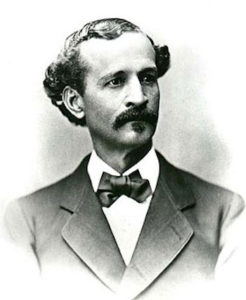
William Hardin
*The birth of William Hardin is celebrated on this date in c. 1831. He was a Black politician and barber.
William Jefferson Hardin was born in Russellville, Kentucky, to a white father and a mulatto mother. He claimed to be the nephew of Benjamin Hardin, but his claims were never proven. He was raised by Shakers in Bowling Green, Kentucky, and began teaching free Blacks in 1849. On June 15, 1850, he married Caroline Catherine Butcher, the daughter of a Black mother and Native American and half-white father. From 1850 to 1855, he prospected for gold in California while his wife moved to Ontario, Canada, due to fears of being sold into slavery.
In December 1862, he became a second lieutenant in the 3rd Louisiana Native Guard Infantry Regiment but resigned in February 1863 to protest white commanders not wanting black people in the regiment. After leaving the army, he traveled through Wisconsin, Iowa, and Nebraska to the western United States before arriving in Denver, Colorado Territory. He became active in Colorado, working at the United States Mint and serving as a delegate to the 1872 Republican National Convention. In 1873, he started working for the United States Mint and married Nellie Davidson, a white woman. However, Caroline Catherine Butcher arrived in Denver. She accused Hardin of being a bigamist, moving to the western United States to avoid being drafted into the army, and of being the father of Mary Elizabeth, who was born in 1858.
Hardin claimed that he was a minor and she was a slave at the time of the marriage, making it illegal. Although he was not charged with bigamy, he was fired from his position at the mint. In 1873, he and Davidson moved to Cheyenne, Wyoming Territory. In 1879, he was elected to Wyoming's Territorial House of Representatives after placing third as a fusion candidate with the Democratic and Republican nominations, thus becoming the first Black member of the Wyoming Legislature. In 1880, he was reelected, although he had attempted to remove his name from the ballot. After finishing eighth with 1,277 votes, he became the only member of the House to serve in both the sixth and seventh sessions. On November 4, 1879, he introduced Speaker H. L. Myrick and was selected to serve on the Indian and Military Affairs Committee and the two-member Joint Standing Committee on Printing.
In 1882, he and Davidson moved to Ogden, Utah Territory, where he opened a barbershop with David L. Lemon. Davidson later left him to marry another man. In August 1883, he moved to Park City, Utah, where he opened another barbershop. In 1889, he found Davidson in Seattle, Washington, and attempted to convince her to return to him now that she was a widow, but he failed. On September 13, 1889, he committed suicide in Park City, Utah, by shooting himself in the heart.